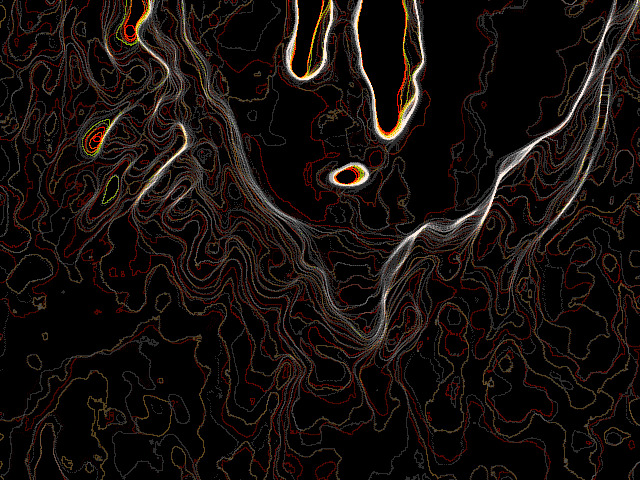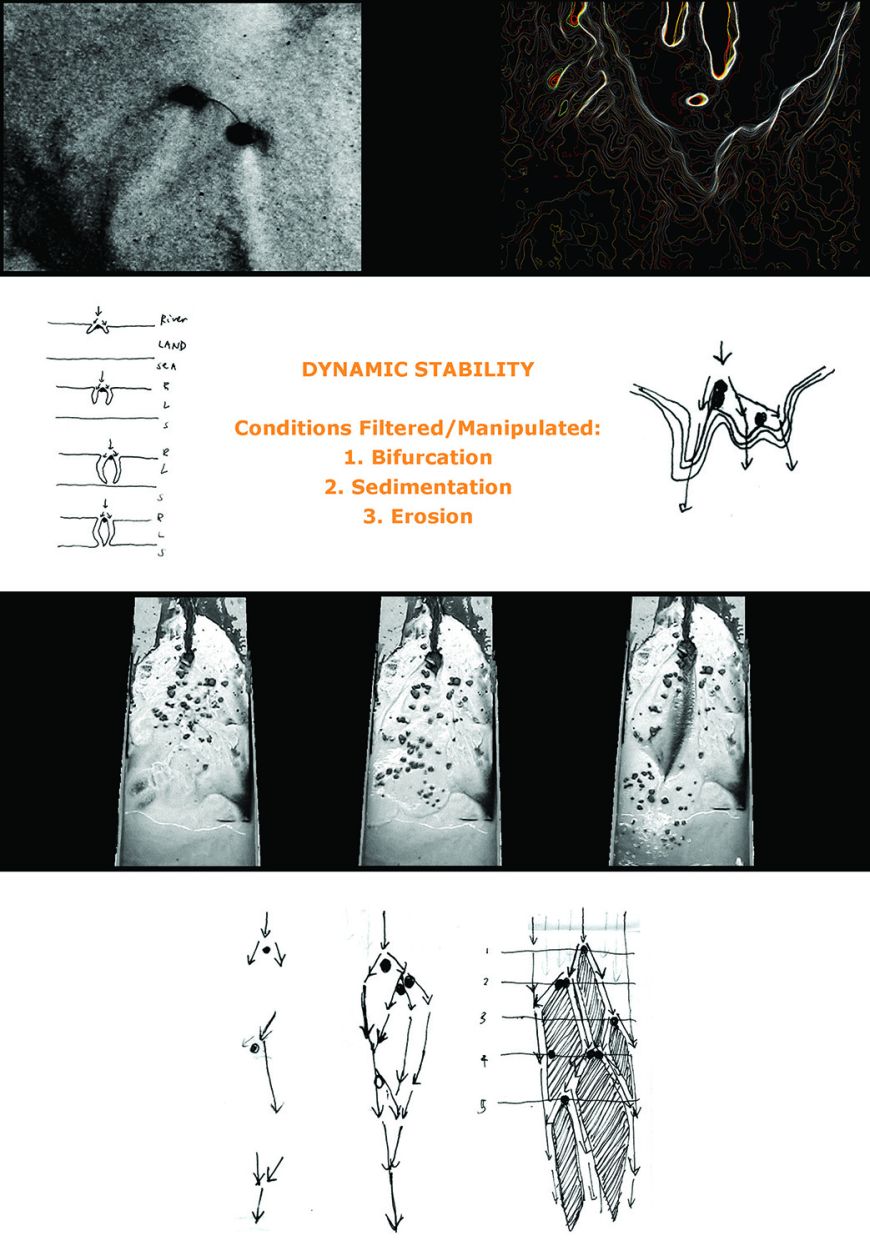FLUID TERRITORIES
Mississippi River Delta
2006
Project with Professor Pablo Lorenzo Eiroa at The Cooper Union 2006.
Excerpt from http://e-architects.net/Cooper-Union-Digital-Ecologies-2006.htm
...
ORGANIZATIONAL SIMULATION OF FLUID TERRITORIES
Students: Jeramie Waechter, Sy Lyng Yong and Katheleen Brumder
INTRODUCTION
“Progress and catastrophe are the opposite faces of the same coin” Hanna Arendt (1968)
“The State subordinates the hydraulic force to canals, pipes, damns that do not allow turbulence, which obligates movement to go from one point to another, for the space to be striated and measured, for the fluid to depend on the solid, and the flux to proceed passing by parallel laminar series. Instead, the hydraulic model of the nomad science and the war machine consist of expanding by turbulence over a smooth space, in producing a movement that occupies the space and that affects simultaneously all the points, instead of being occupied by itself as a local movement that goes from one point to another. ” Gilles Deleuze and Feliz Guattari “A Thousand Plateaus”
ORGANIZATION AND STRUCTURE
Space and Structure have always been related to architecture’s subject matter. In order for an idea to be of any relevance to deep structure, it has to be able to relate to the structure of that space. Public space and infrastructure play a similar role in that relationship. Architectural ideas concerning public space should relate to its structure. In this sense, infrastructure remains an area untouched by our profession, with few alternatives largely unexplored, where it is only developed by state driven organizations like the Army Corps of Engineers. Since a large amount of energy and economic resources are related to infrastructure renewal and enlargement, the architect, in a side role, should engage a more active participation in order to take these opportunities for large-scale interventions to transform so that they can achieve a more sensible role to the urban space. The problems of infrastructure excess and infrastructure redundancy are produced as everyday common interventions and present continuous opportunities for architecture interventions to affect the city at large.
There is a known shift in worldwide port cities over the turn of the 20th century that involves the recycling of the port’s infrastructure in order to incorporate the ports into the fabric of the city. The shift produced by maritime global exchange, presents a background for a less developed problem. The shift in the incorporation of these structures, which were originally designed for different scales, purposes, and then domesticated by cities, mark a special social shift in the perception of urban space structures. On the other hand, those same cities are challenged by a parallel problem, in relation to the same areas of exchange between city and water. Today, water control systems are the focus of attention of many states, since not only the rising levels of underground water affect cities in floods with water coming from underneath, but also from borders facing open waters or rivers, with problems of containing the increasing pressure of water. As studied at Princeton University, the effects produced by global warming present the case that in 100 years, the tide will raise 2 feet globally, an equivalent of .60m (for instance, the shore of New Jersey and its beaches will be receding by 240 feet (80m).
INFRASTRUCTURE EXCESS AND ARCHITECTURE AS EXCESS
Infrastructure today has no time, it is always new and replaced for the new, instead of growing and adapting organically with the city. A more open-ended comprehensive thinking of the public space in relation to infrastructure is necessary. A strategy with these bases could adapt to new uses proposing an alternative behavior. Public space and its structure must incorporate accumulation of time, effects, functions, and layering of problems, which continuously transform within time. Infrastructure interventions progressively have become simple engineering, linear solutions, while opportunities for integration in a more comprehensive urban design panorama are being simplified by shallow economic thinking. Its excess, its qualities, and side effects as well as its urban potential are eliminated as non-critical interventions become aggressive, eliminating any possibility of those landscapes to acquire identity or quality by simple substitution. Homogenization, standardization, simplification and insensibility are the only means to measure itself with anything else other than its immediate simplified purpose of its construction. Many times we can notice that infrastructure is replaced by building parallel infrastructures, with increasing simplification. The excess and replacement become unproductive redundancy because of the new rigid design, which derives only by multiplication of the same problems it tries to solve. A demand for accumulation by time instead of replacement is necessary. Integration rather than elimination and a comprehensive inclusion can only use time as a tool to accumulate complexity rather than beginning new in each case.
Since Hurricane Katrina, current solutions for controlling New Orleans’ possible future floods will include the building of extra large infrastructure interventions with a degree of structural excess. Architects in this context can use, boost, and redirect this excess towards developing landscape architecture operations out of infrastructure deviations, side effects or latent opportunities in resistance by using infrastructure together with the existing environmental forces. A more creative and dynamically efficient determination of the structure of public space will allow for these large infrastructure interventions to operate at a more adequate and sensible scale. In this way, allowing spatial architecture strategies and public space to be conceived, which otherwise, without compromising the structure (infrastructure) of that public space will tend to be restricted to work as urban decoration.
SEMINAR LAYOUT
A specific response to the area affected by the Hurricane Katrina, starts to inform problems which may end up activating design strategies and specific speculations. Preliminary analog research of specific conditions of interest within the site and then specifically related to the events of Katrina are tested, resisted and recorded digitally to understand them by filtering pieces of collected information. Following those tests, classification in terms of qualification and quantification allows for that material to be more determinate in a certain artificial parameter, understood in terms of gradients of behavior and scales of modalities, by this operative means start thinking how one might be able to manipulate those analyzed problems. Creative observation determinates the scope of the analysis and the generation of material to study and apply.
Experimentation and testing included parallel physical bodies’ problems of weight, density, fluidity, tectonics and resistances, against immaterial agents such as forces of gravity, inertia, vectors, directions and turbulences. These forces were tested and compared against real forces and then the computer worked as a tool to classify, catalog, and measure specifically those interactions. As an architect may take an architectural section to study a certain object, the model, in our case, was filtered digitally to understand parts as a layered condition in which visualizing and separating systems of information that then can be classified, ordered and studied separated.
Time was understood in three different modalities which would relate to organization time, phasing and ultimate stability. Organizational time was worked so that the design and development of the project is understood on a dynamic basis of interaction between information that may change on a time basis, so then the project would have to assume that the organization might evolve responding to the shift of the different conditions. Phasing is understood in a conventional way with the exception that is taken as an opportunity for consistent change or adaptability: program may change, grow or transformed as well as the physical conditions of the project informed by their construction phases. Ultimate Stability refers to the progressive accumulative deceleration of instability or change in the project. In reaching the ultimate span of its active organizational life, it becomes more stable as things more fixed, and starting then a more productive phase in its development.
MATERIAL EFFECTS
Working with concepts of entropy, the course looked at environmental processes as material processes which the students could relate physically to understand and manipulate in scale. By developing a system of exchange of information, one may focus and study a particular effect to understand a larger process. Those material processes will then be dynamically studied and simulated again through digital dynamic interfaces. The research on New Orleans’ Infrastructure and environmental processes, as well as latent infrastructure side effects, were used to study how to propagate, accelerate or decelerate certain selected processes to manipulate these anomalies to generate landscape opportunities as feedback, as it happened before with the crop fields.
REPRESENTATION vs SIMULATION:
“Today abstraction is no longer that of the map, the double, the mirror, or the concept. Simulation is no longer that of a territory, a referential being, or a substance. It is the generation by models of a real without origin or reality: a hyperreal. The territory no longer precedes the map, nor does it survive it. It is nevertheless the map that precedes the territory – precession of simulacra—that engenders the territory, … It is the real, and not the map, whose vestiges persist here and there in the deserts that are no longer those of the Empire, but ours. The desert of the real itself”.Jean Baudrillard, Simulacra and Simulation.
By applying certain digital frames to animated sequences of the analog research, a new digital material becomes visible and operative. Framing, layering and filtering with digital tools becomes a mode to select information. Forced distortion and manipulation should be discerned between excessive information. A creative vision of “what to look for,” and “how to look,” became two faces of the same problem related to interpretation and reading. In this sense, a more active and important role to representation started activating the problem of presentation as opposed to representation.
One of the ideas worked through this specific medium was to present rather than represent actions, problems, solutions and speculations. Animation was then understood not only as a representation in time, but as a way to think and understand the constitution and construction of form within time. A strategy, which uses time to build up form, would be able to include more evidence or data as well as dynamic input that would progressively become incorporated as new problems and shifts to solve.





